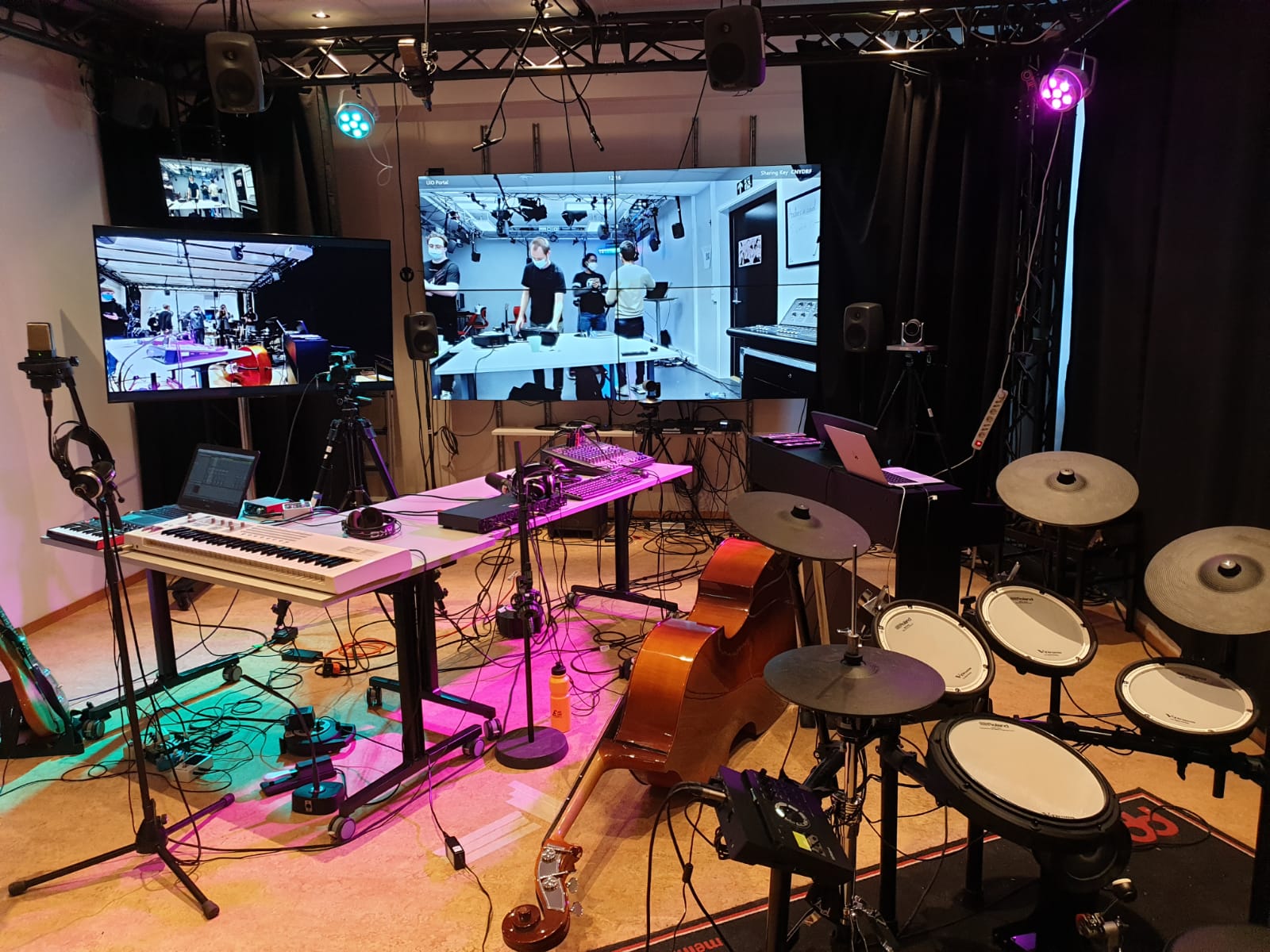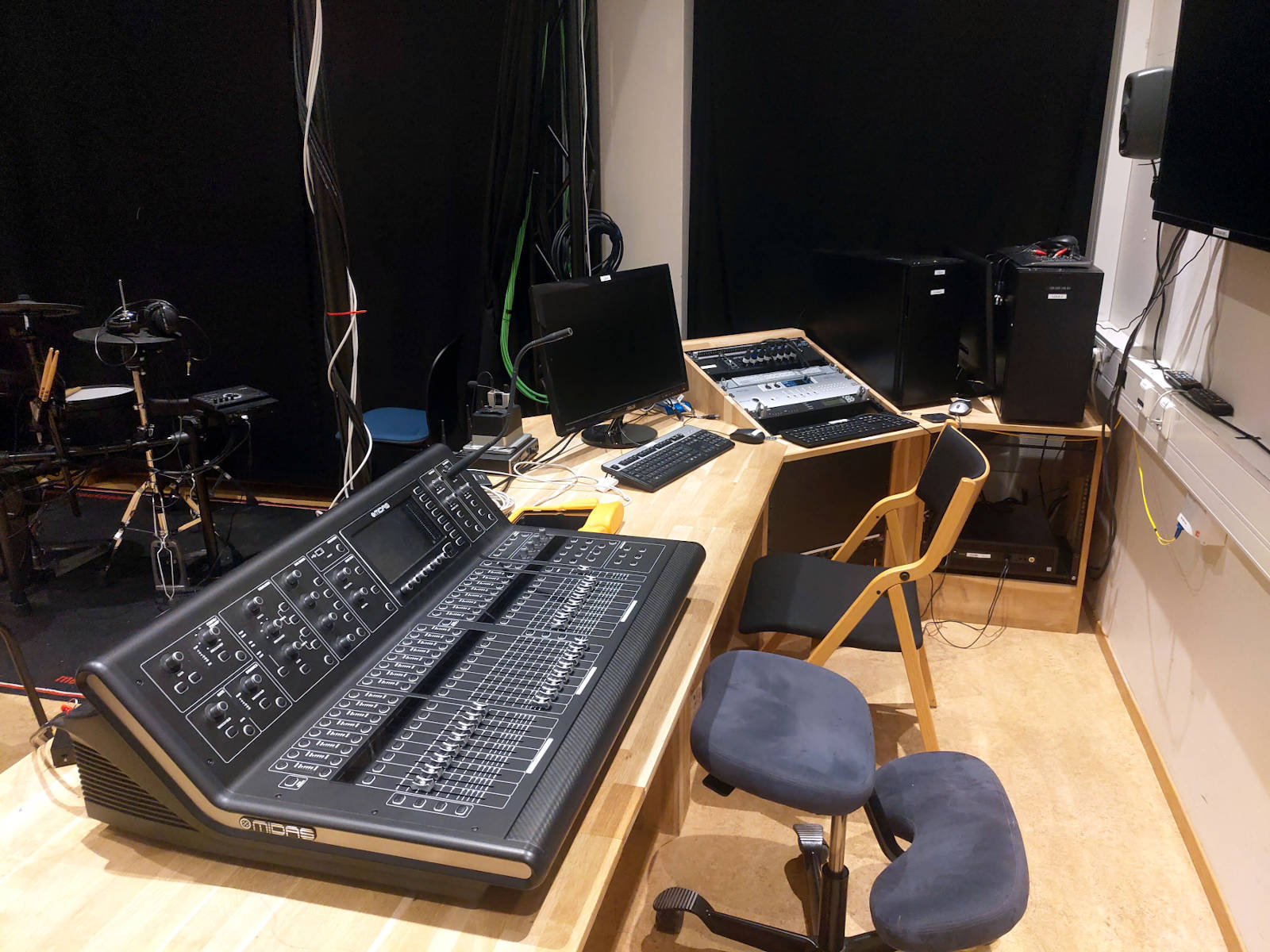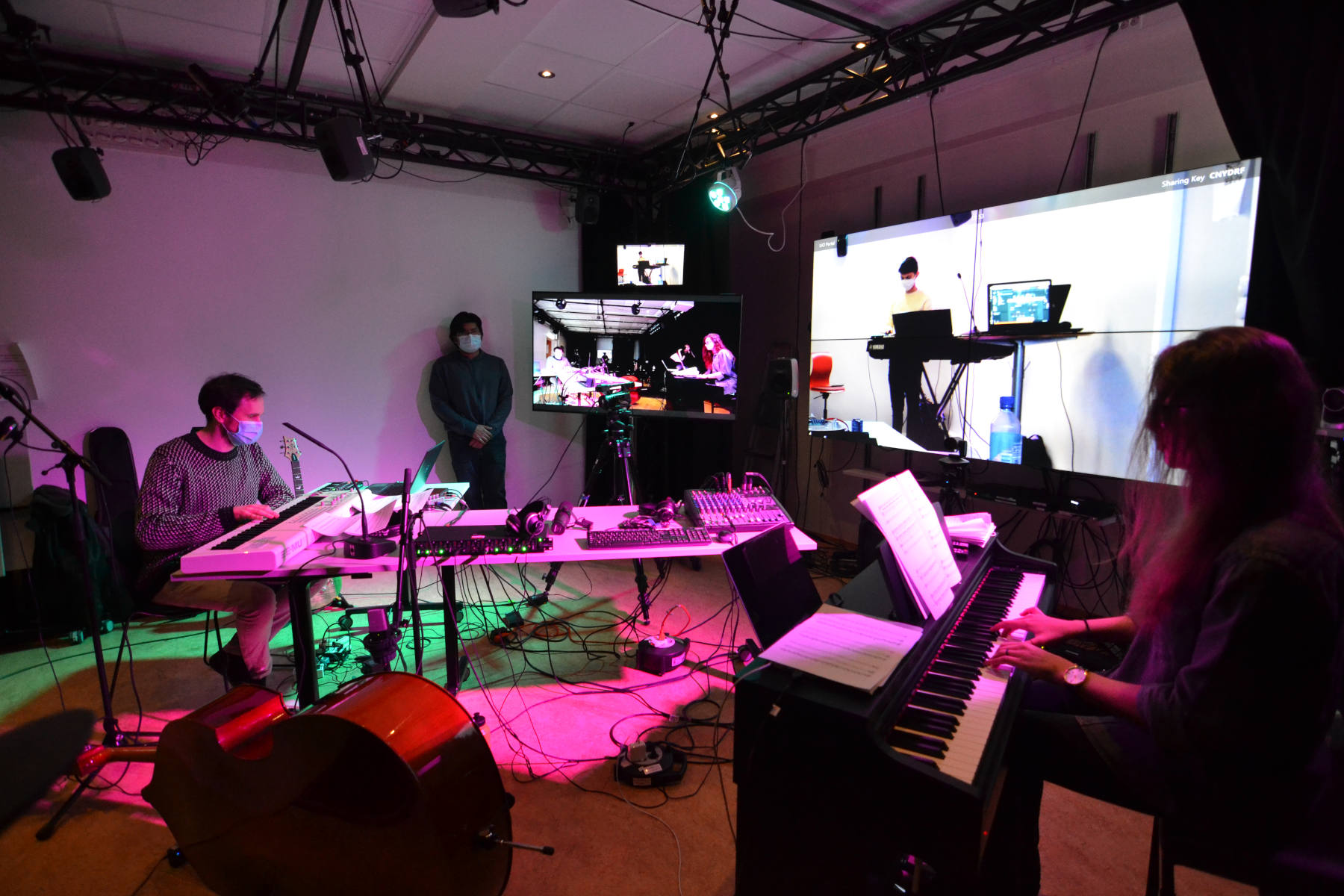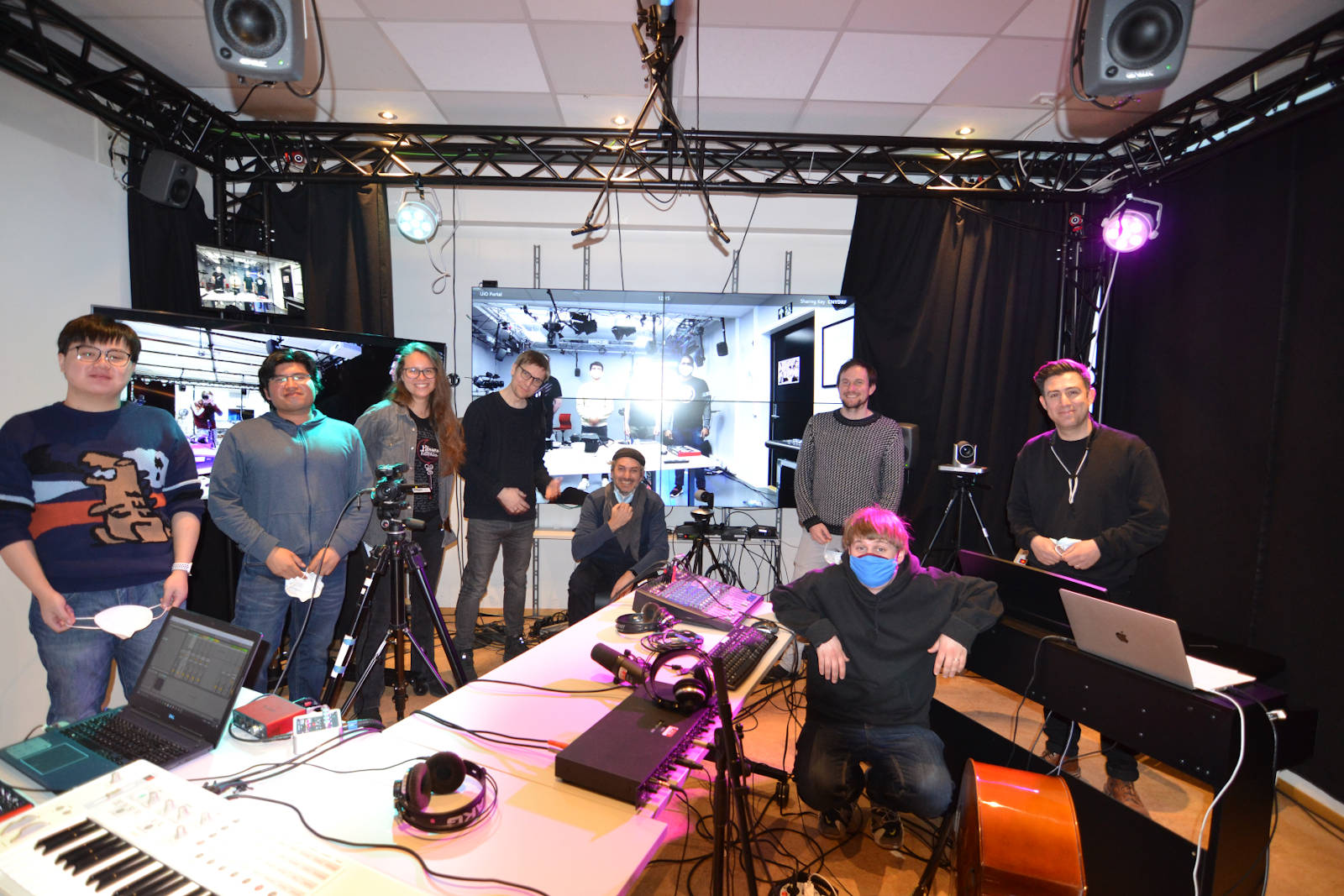The MCT Portal through the eyes of a noob
The MCT Portal in Oslo: a noob’s quick guide and experiences

First steps in the MCT Portal
During our first semester (fall 2020) as part of the MCT Master’s program, we had an online course that introduced us to several software that could be used for communication and performance purposes (e.g. Zoom and JamKazam). We also refreshed our knowledge (or, if we had no previous knowledge, like me, we learned) about basic acoustic principles and several audio and video devices used in the digital world and their working principles. All this helped build a theoretical foundation for the practical activities of the second semester (spring 2021).
As a complete noob in the area of audio-visual technologies, stepping into the MCT Portal was overwhelming, even after the semester I spent learning about it online. Seeing the mixer nook sent shivers down my spine, and I started wondering how was I going to do remember everything, I had so much to learn…

Building up knowledge throughout the semester
After the initial shock, things settled down. Slowly, I started to understand the language spoken around me and learn the abbreviations (seriously, in this field almost everything is referred to by their brand and model number or other technical details!). The first step for me was to understand the devices that make up the Portal, and I managed this through a combination of shadowing Guy (our teacher) and my more-knowledgeable classmates around, asking sometimes annoyingly basic questions, and researching online. Here are a few of the main things I learned that might be useful for all of you noobs like me who will step foot in the Portal and wonder where to start.
A normal day in the Portal: communication channels
In the portal we have two main communication channels that we use “daily” (meaning, for every session we are in contact with our classmates located in Trondheim). This is part of the basic turning on/off routine. For more information about what we do in the Portal and what can it be used for, see all our blog posts regarding the Portal.
-
We first establish a Zoom connection, which uses the Logitech PTZ Pro 2 Camera part of the Logitech GROUP video conferencing system. This is our backup plan, in case the low latency channels (see below) are not working immediately and need additional troubleshooting. We also have an “alternative Zoom” on another PC at the back of the Portal, paired with a Logitech MeetUp); this is especially useful when we need a to share a different camera angle (for example during classes when it’s necessary to show the mixer). It is not possible to use Zoom for telematic performances, the latency is simply too big.
-
After Zoom is up and running, we establish an audio connection using LoLa, our LOw LAtency and high quality software based transmission system. We pair this up with a video connection using TICO, our hardware based TIny COdec compression technology - tiny in complexity, latency and compression. For this we use a Minrray PTZ camera (Pan-Tilt-Zoom) which has an unbelievably awesome image quality. This camera is also linked to the Zoom Room PC, but this semester e only used it for TICO. For telematic performances, this LoLa-TICO solution is the only one worth trying, and even then it will not be possible to play completely on time. See a snippet of our rehearsals below:
Technicalities
To facilitate the communication and performance in this special room there are a few other worth noting devices I had to familiarize myself with, or at least understand their purpose. And I’m not talking about the speakers or screens in the room, that’s quite intuitive. I’m talking about the mixer (I postponed talking about this one enough), the stage box and the HDMI matrix.
- The Mixer: Even having had no experience with audio-visual technologies before (more than my laptop, phone, a semi-professional Sony camera my dad had and the Microlab speaker system I got as a present for my 18th birthday), I still knew how a cool mixer is supposed to look like - a relatively big box like item, with a lot of buttons, knobs and faders (yes, I learned the correct names just recently), and millions of cables sticking out of it, connected to a bunch of instruments, speakers and microphones. Pretty basic, really. Not! It took me at least two classes to be brave enough to even start discovering how to use our Midas M32 Mixer more than just look at what other people did. In time, however, I learned more and more about it and stopped intimidating me that much. I still haven’t used it to its entire capacity, probably more like half, but I’m proud of my progress. I went from not knowing what an XLR cable is and anything about input channels, preamplifiers, auxiliary channels, mix buses to actually being able to connect an instrument or microphone to the mixer and routing it to the output I wanted (for example, sending the sound only to LoLa and the room speakers, but no Zoom), controlling its gain and getting rid of the feedback (and avoiding it in the first place), and saving my setup preferences in a separate scene. I just had to give it time, ask a lot of questions and practice/try as much as possible and learn from my mistakes; it ends up being quite logical after a while.
-
The Stagebox: This name is intuitive enough, but I still had to research its correct usage. It is an interface that simply connects microphones, speakers and instruments to the mixer, allowing for a longer distance between the “stage” and the sound desk. In the Portal, it’s useful because the room is quite long, with a lot of microphones and instruments and speakers places everywhere; so, it simplifies setup to have a stage box in front of the room and the mixer in the back and also helps with not having too long cables.
-
The HDMI matrix: For an embarrassingly long time I thought the HDMI matrix was the main screen in the Portal, which consists of four smaller screen = a matrix; it was frustrating to try to turn it on and not see any feedback. After this happened a few times, I searched what an HDMI matrix actually is, I identified it in front of the room and finally spent some time understanding how it works, feeling relieved I never voiced out loud my misconception (well, now you all now, so don’t laugh). Just to put it out there, an HDMI matrix, also called a switcher, is a device used for customizing high speed audio-visual signal routing from multiple sources to multiple destinations. It’s a very useful device since in the Portal we have the Zoom PC and TICO (at the very least) sending visual signals to two screens (and even a projector).
My contributions
Due to the considerable knowledge gap between myself and the rest of my classmates, I didn’t contribute with a lot. I was happy learning from everybody and consolidating what I was slowly learning by myself. Taking the responsibility to turn on/off everything in the room and establish the communication channels, with some simple troubleshooting, was enough for me to feel immense progress. During our rehearsals for the end of semester concert, I also learned how to connect instruments to the mixer, and process the sound a bit with some gain and equalization. At least for my group, I managed with some basic knowledge of the input channels and mix buses and a bit of logic to figure out and fix our feedback problems: instead of only sending our mics and/or instruments to LoLa (to Trondheim), we also routed them back to our own system, and sometimes we would even route the sound we got from Trondheim back to them. I also proposed that we make the TICO - Minrray PTZ camera setup a more permanent solution, to avoid having to connect the SDI cables every class and having them in the middle of the room, and the idea gain traction and we managed to improve the Portal user-friendliness by a lot.
What I used the knowledge for: The accomplishments
The Mocap data capturing
This semester I also attended the Music-related motion tracking course (MCT 4043). For the final project, I chose to use the Optitrack motion capture system set up in the Portal to capture some dancing data. For this, it was extremely useful to know how to navigate the room. I was able to use the setup to my advantage and it felt like a great accomplishment to be able to get in the room by myself, set up everything, troubleshoot some weird audio routing with the mixer and the alternative Zoom machine, and answer my participant’s questions about what was this or that used for; it was empowering. Well, except the time I thought that the receiver for the conference mics was actually a LAN router of sorts, but hey, we learn something new every day. You can read more about my project for the Motion tracking course in this post.
End of semester concert
For the end of semester concert, my responsibilities were a bit less technically inclined on the day. I was part of the promo and design team, and although we did a good job having everything ready on time, our Facebook posts were deleted by the curators and we didn’t get permission to post in time to promote the concert properly. During the concert day, I was a presenter and although I have some experience with this position, I have to say it was weirder than I thought to present in front of a camera instead of a room of people, and not be able to “feel the crowd”. I stumbled a bit over my words, but it ended up good - I managed to charm our extremely large audience and they didn’t mind. Here’s a muted video of my antics while waiting for sound - to prove that not everything is milk and honey even after several sound checks…
As part of the A(wesome) ensemble, I played the piano first with some midi effects and then without any. It was a completely new experience for me from two points of view: a) I was only ever part of classical music ensamples, so I had no experience playing in a band in the rock-jazzy sense or an electric instrument for that matter; b) For me, experiencing the telematic performance and working with the latency and all other implications was new and frustrating at times, same as for everybody. The performance ended up being successful, and I did manage to feel part of a band, even if we were not all in the same room. For more details about our mixing and instrumentation, check out this other post), and for a recording of our live stream go here (you might want to skip the first several minutes while we worked out some sound issues).

Reflections
I have to say that in the beginning of the semester I was extremely skeptical towards “telematic performances”, I couldn’t see how that would work in a nice way. At the end of the semester, I’m still skeptical, but only because as a classical musician it does not have enough warmth for me - I don’t feel the audience and the other musicians the same - and the entire electronic setup fills up my attention with unwanted background noise and unexpected issues that would never appear when you only have your (analog!) instrument and an audience (sure, the audience is sometimes noisy as well, but in a different way than dozens of devices around you). Also, I now certainly know how telematic performances work, their ups and downs and that they have the potential of working, providing you erase your previous musical experiences and take it as it is - a way for musicians across the world to connect and play music together from hundreds or thousands of kilometers away, which is in and of itself a huge accomplishment.
Besides the telematic performance aspect, this course taught be a lot about audio visual technologies in general, which is something I’ve been meaning to understand more about. It is great to now know enough to not feel completely lost around a studio, for example, or concert setup. Even if I still have a long way to go to reach the level of some of my classmates, I believe I made the most out of this course. There were frustrating aspects of the course, but it was awesome to finally be on campus and do something practical, learn from my own mistakes, and have such a nice end of semester concert. Thank you for this course!

